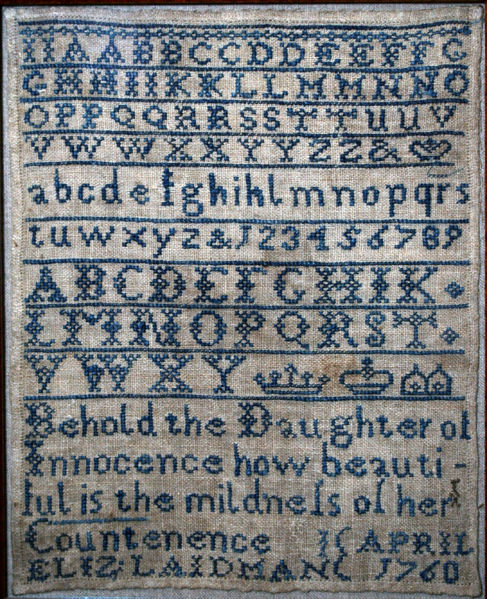
Elizabeth_Laidman,_1760.jpg
A skill taught to centuries of girls across multiple countries and cultures, cross-stitch has been an educational tool, an art, a hobby, and a subversive form of protest. Part two looks at cross-stitch samplers and the girls who created them.
If I had been a girl in 1637, 1745, 1829 or even 1909, I likely would have despised cross-stitch. For centuries, most girls didn’t have a choice as to whether they wanted to learn it. A girl was often expected to grow up, get married, have children, and take care of a home. Her education included music, painting, manners, sewing – and cross-stitch.
Most girls created two ‘samplers’ as part of her preparation for the responsibility of sewing clothes and linen for her future family. Samplers often included the alphabet, numbers, decorative borders, flowers, animal motifs and sometimes the name of the girl who stitched it and the date it was completed. An old-fashioned resume, samplers displayed the needlework skill of the stitcher.
The first samplers were created in the 15th century. The earliest surviving sampler is from 1598, stitched by English girl Jane Bostocke just over 400 years ago. Jane’s sampler contains an owl in a tree, a dog with a collar and lead, a lion, a chained bear in a field of daisies, a squirrel and even a pelican. Commemorating the birth of her cousin, Alice, two years earlier, the sampler likely took Jane two years to create.
One of the original pilgrims to arrive in the early American colonies, Loara Standish created a sampler around 1640. Created when she was about 13, Loara’s sampler is decorated with bands of stylised flowers, acorns, and her intricately stitched signature. Loara died young, but her sampler lived on – kept by her family until it was donated to the Pilgrim Hall Museum in Plymouth, Massachusetts in 1844.
In the 19th century, samplers became an integral part of the school curriculum for girls. Girls from six to fifteen would sew samplers – and not just with the alphabet, but with maps to learn geography, and mathematics to learn multiplication tables. In orphanages and boarding schools, samplers evolved into a recognisable style with the same colour stitching and stitching skills the girls would need if employed in domestic service. This sampler was made by eight-year-old Edith Grace when she was a pupil at Arnot Street Boarding School in Liverpool. Can you imagine one of your school assignments becoming a museum piece?
Samplers have played an important part in recording the lives of girls, particularly those lives which would have often otherwise gone unrecorded. If you’re keen to learn more about the history of samplers, follow this link.
The next time you visit a museum, why don’t you check to see if they have samplers? You might be inspired to create your own!
-Rosalie Elliffe
Junior Girl
Girl Museum Inc.
